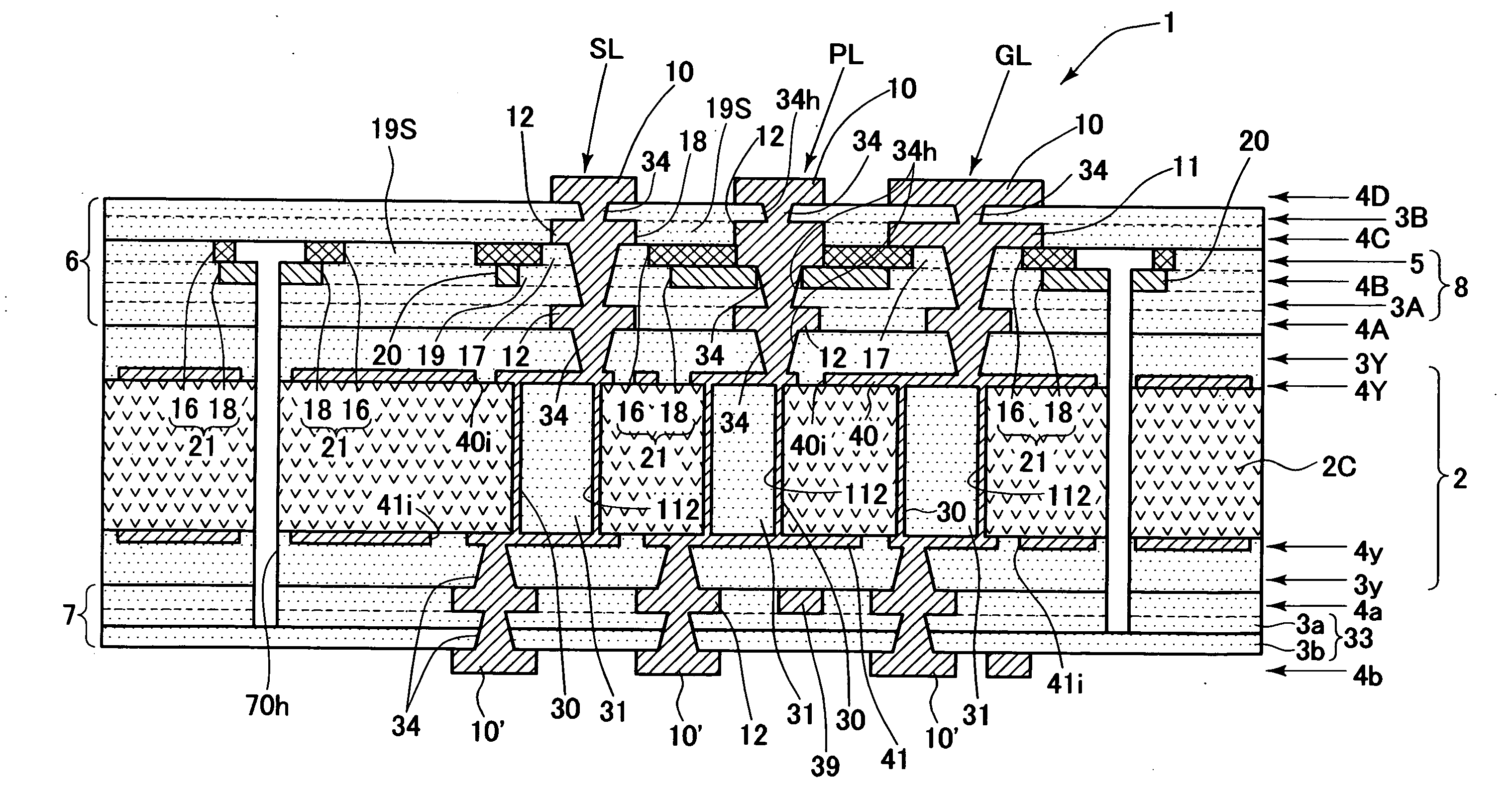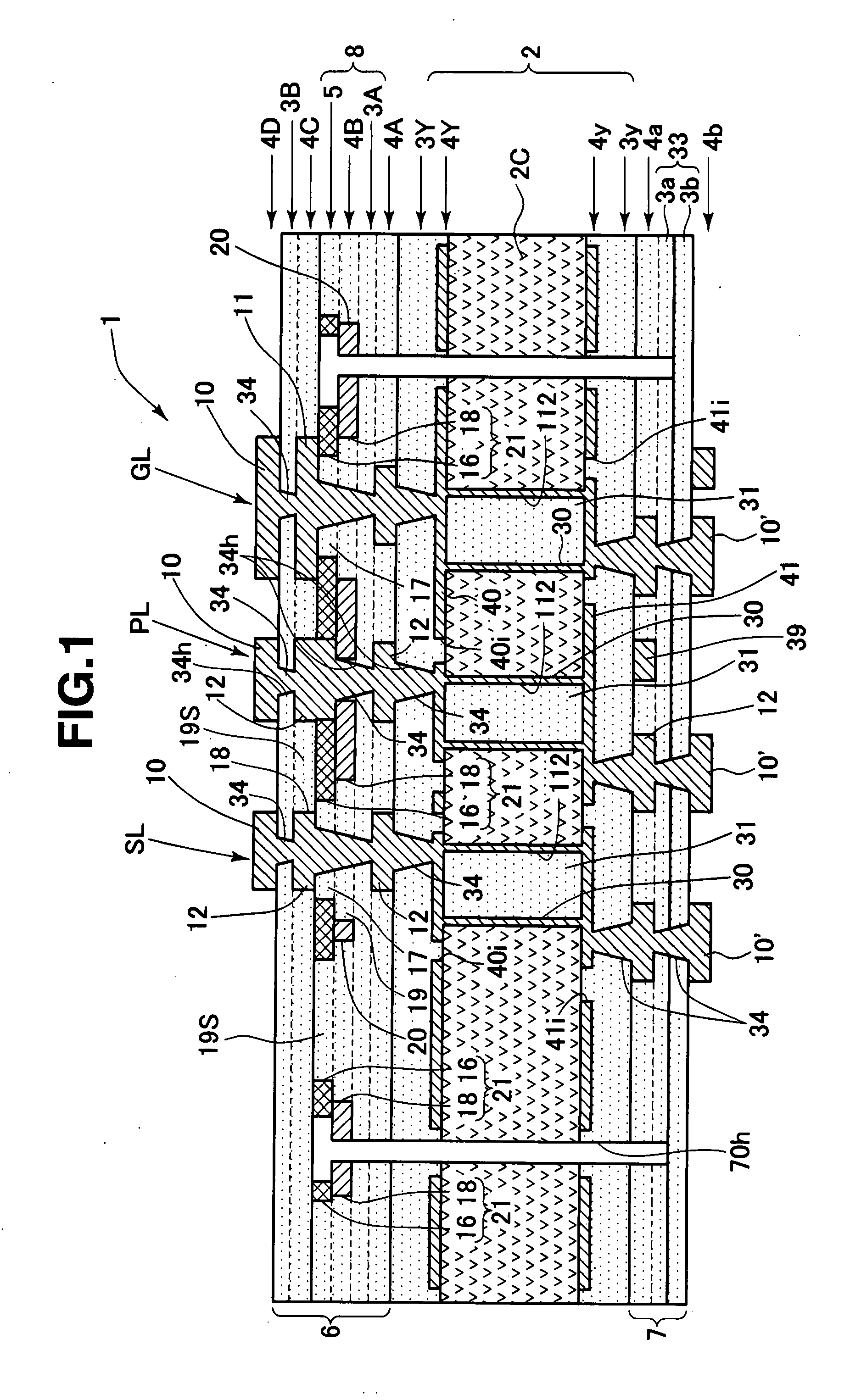Since in an
integrated circuit device such as CPU and other LSI that operates at high speed, power source wires branching off from a common power source are allotted to a plurality of circuit blocks within an integrated circuit, there is a problem that when a number of elements within the circuit blocks perform high-speed switching at the same time, large current is drawn from the power source at one time and a resulting variation in the power source
voltage will become a kind of noise, which noise is transmitted to the respective circuit blocks through the power source wires.
In the meantime, in case of a large-scale integrated circuit such as CPU, the number of circuit blocks formed therein is large and there is a tendency that the number of power source terminals and ground terminals increases, so that the distance between the terminals is decreasing more and more.
A
decoupling capacitor needs to be connected to each power source wire extending toward each circuit block, so that it is not only difficult from a point of view of a mounting technology but it goes against a miniaturizing trend or the like to connect capacitors separately to an integrated circuit having a number of densely arranged terminals.
Further, there is such a problem that the
inductance of a terminal portion, when increased, is combined with a capacity component of a
decoupling capacitor to cause a
resonance point, thus making smaller the
band width where a sufficient impedance reduction effect is obtained.
However, in the above-described
patent document 1, there is provided a structure in which a
capacitor is installed on an intermediate board interposed between an electronic part and a wiring board, thus causing a problem that the working time necessitated for installation of the electronic part on the wiring board is increased for the interposition of the intermediate board and it becomes difficult to make the
assembly of the wiring board and the electronic part be lower in height.
This makes it possible to realize decrease in the height of the
assembly but the following problem arises.
Namely, the adhering strength between the build-up layer and the
capacitor portion is liable to decrease, particularly when a
thermal cycle such as a reflow process for flip-
chip connection of an electronic part is applied to the build-up layer and the
capacitor portion, the thermal
shear stress level between the
layers due to the difference in the line expansion coefficient between the build-up layer and the high inductive ceramic layer becomes higher, thus being liable to cause a problem of peeling or the like.
Further, the capacitor using a
thin layer of high inductive ceramic is difficult in handing at the time of connection to the build-up layer for wiring, thus causing a problem of a low
manufacturing efficiency.
Further, by the prior technology, there is caused the following problems since the capacity to be formed is increased by forming the capacitor at an area that is determined as wide as possible with respect to the size of the external shape of a single unit (
package) of wiring board but the capacitor portions are cut at the time of dicing if the single unit of wiring board and the capacitor have the same size.
(2) The adherence at the interface between an
electrode and a ceramic
dielectric layer is weaker as compared with that between polymeric materials, thus possibly causing interlayer peeling due to shearing stress at the time of dicing and an intrusion path for intake of
moisture thereafter.
(3) Sagging of an electrode made of
metal such as Cu is liable to occur at the time of dicing, and shortage occurs between the
layers.
(4) As compared with a single polymeric substance, an electrode made of
metal such as Cu, particularly a ceramic dielectric layer made of high dielectric such as
titanic acid barium increases the load at the time of dicing and accelerates wear and chipping of a blade.
In case such a structure is employed, the following problems arise.
One problem is that treatment liquid used for forming a capacitor on the first side causes an influence on elements on the second side.
Particularly, desmear treatment liquid used for removing residue at via holes causes a problem since it corrodes a polymeric material.
However, such a theory cannot be used in case a capacitor having a ceramic dielectric layer is formed only on one side of a core board portion.
This fact means that it is difficult to form plating
layers of a uniform thickness and a
uniform quality on the first and second sides.
Another problem is that the first and second sides become unequal in the mechanical characteristics depending upon whether they are formed with a capacitor.
This fact means that a defect such as bending or peeling is liable to be caused after a thermal history.
 Login to View More
Login to View More 


